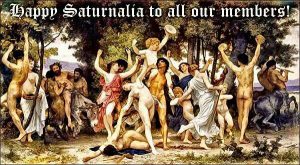第四章 男根崇拝,禁欲主義および罪 n.1
父性の事実が初めて発見された時以来,性はつねに宗教にとって大いなる関心事であった。このことは,(最初から人が)予想するであろう(予想された)ことにすぎない。宗教は,神秘的かつ重要なことであれば何でも関心を寄せるからである。農業及び牧畜時代の初期においては,作物(収穫物)や羊や牛の群れや,あるいは女性の実りの多さ(多産であること)は,男性にとって最も重要なことであった。作物はいつも豊作であることはなかったし,性交はいつも妊娠を引き起こすことはなかった。望む結果を確実にするために,宗教や柔術(魔術)に救いを求めた。類感呪術(注:systematic magic 交感呪術)の日常的な観念に従って人間の多産を促すことで土地の豊穣さを助長することができ,そうして,多くの原始社会の願いである人間の多産そのものは,種々の宗教的・呪術的な儀式で促進されると考えられていた(のである)。
古代エジプトでは -母系制時代の終わらないうちに農業が起こったようであるが- 宗教の中の性的要素は,初めは男根的なもの(男根崇拝的なもの)ではなく,女性の生殖器とかかわりがあり,女性器の形は子安貝(cowry shell)によって示唆されると考えられ,それゆえに,子安貝は魔力を持つとされ,また,通貨として使用されるようになった。
けれども,この段階は過ぎ去り,後期エジプトにおいて,大部分の古代文明の場合と同様に,宗教の中の性的要素は男根崇拝のかたちをとった。このことに関する最も顕著な事実の簡潔できわめてすぐれた記述が,ロバート・ブリフォールト(著)『文明における性』の一章に見いだされる。(注:V. F. クラヴァートン,S. D. シュマールハウゼン編,ハヴェロック・エリス序。ロンドン,アレン&アンウイン社,1929年刊)
 (彼は言う,)農業祭,特に種まきや作物の収穫に関わる祭りは,世界のあらゆる地域や,あらゆる時代にわたって,一般的な性的放縦(general sexual licence)の最も目立った例を提供している。……アルジェリアの農民たちは,彼らの中の女性たちの性的放縦さにどのような制約が加えられても,性道徳を強制しようとする試みは,すべて農作業の成功をさまたげるという根拠(理由)から,憤慨する。アテネのテスモフォリア(Thesmophoria),つまり,種まき祭は,弱められた形で,元来の多産の呪術の性格をとどめていた。女性たちは,男根のシンボルを持ち歩き,みだらな言葉を口にした。農神祭(satunalia)は,ローマの種まき祭であり,それは南ヨーロッパのカーニバルに継承されており,そこでは,スー族やダオメ一族の間でよく見られるものとほとんど違わないような男根のシンボルが,ごく最近まで異彩を放つ特徴であった。(注:ブリフォールト,前掲書,p.34)
(彼は言う,)農業祭,特に種まきや作物の収穫に関わる祭りは,世界のあらゆる地域や,あらゆる時代にわたって,一般的な性的放縦(general sexual licence)の最も目立った例を提供している。……アルジェリアの農民たちは,彼らの中の女性たちの性的放縦さにどのような制約が加えられても,性道徳を強制しようとする試みは,すべて農作業の成功をさまたげるという根拠(理由)から,憤慨する。アテネのテスモフォリア(Thesmophoria),つまり,種まき祭は,弱められた形で,元来の多産の呪術の性格をとどめていた。女性たちは,男根のシンボルを持ち歩き,みだらな言葉を口にした。農神祭(satunalia)は,ローマの種まき祭であり,それは南ヨーロッパのカーニバルに継承されており,そこでは,スー族やダオメ一族の間でよく見られるものとほとんど違わないような男根のシンボルが,ごく最近まで異彩を放つ特徴であった。(注:ブリフォールト,前掲書,p.34)
Chapter IV Phallic Worship, Asceticism and Sin
From the time that the fact of paternity was first discovered, sex has always been a matter of great interest to religion. This is only what one would expect, since religion concerns itself with everything that is mysterious and important. Fruitfulness, whether of crops, or of flocks and herds, or of women, was of prime importance to men in the beginnings of the agricultural and pastoral stages. Crops did not always nourish and intercourse did not always produce pregnancy. Religion and magic were invoked to make sure of the desired result. In accordance with the usual ideas of sympathetic magic, it was thought that by promoting human fertility the fertility of the soil could be encouraged ; and human fertility itself, which was desired in many primitive communities, was promoted by various religious and magical ceremonies. In ancient Egypt, where agriculture appears to have risen before the end of the matrilineal epoch, the sexual element in religion was at first not phallic but concerned with the female genitalia, the shape of which was supposed to be suggested by the cowry shell, which accordingly was held to have magic powers and came to be used as currency. This stage, however, passed away, and in later Egypt, as in most ancient civilizations, the sexual element in religion took the form of phallic worship. A very good short account of the most salient facts in this connection will be found in a chapter by Robert Briffault in Sex in Civilizaiion.(note 1: Edited by V. F. Claverton and S. D. Schmalhausen, with an introduction by Havelock Ellis. London : George Allen and Unwin Ltd., I929.)
Agricultural festivals (he says), and more especially those connected with the planting of seed and the gathering of harvest, present in every region of the world and in every age the most conspicuous examples of general sexual licence …. The agricultural populations of Algeria resent any restriction being placed upon the licentiousness of their women upon the ground that any attempt to enforce sexual morality would be prejudicial to the success of their agricultural operations. The Athenian thesmophoria, or sowing-feasts, preserved in an attenuated form the original character of the magic of fertility. The women carried phallic emblems and uttered obscenities. The saturnalia were the Roman feasts of sowing, and have been succeeded by the carnival of Southern Europe, in which phallic symbols, differing little from those in vogue among the Sioux and in Dahomey, were down to recent years a conspicuous feature.(note 2: 2 Briffault, loc. cit., p. 34.)
出典: Marriage and Morals, 1929.
詳細情報:http://russell-j.com/beginner/MM04-010.HTM
<寸言>
豊穣を祈ったり、感謝したりする農業祭で、男性や女性の性器をもって練り歩く姿は世界各地で今でも見られる。
